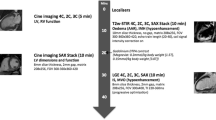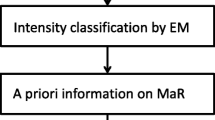Abstract
Background
In clinical routine, rapid infarct sizing techniques are warranted, as objective and precise infarct sizing is important for clinical decision-making. Accurate and objective measures of relative infarct size (rIS) using contrast-enhanced cardiac magnetic resonance (ceCMR) have been extensively demonstrated in experimental animals, but less in humans. The aim of this study was therefore to quantify rIS assessed by ceCMR in patients with chronic myocardial infarction using semi-automatic quantitation techniques.
Methods
A total of 62 patients (mean age 66 ± 9 years) with ischemic cardiomyopathy (EF 24 ± 8%) underwent ceCMR for viability testing. rIS was obtained by two time-saving semi-automatic thresholding methods based on: (1) visual definition of a single signal intensity cutoff value (VISUAL) and (2) the full-width-at-half-maximum technique (FWHM). Results were compared to manual tracing (MANUAL) as the reference standard.
Results
VISUAL showed better agreement [r = 0.99; intraclass correlation coefficient (ICC) = 0.98, limits of agreement ±3.2%] to MANUAL than the FWHM technique (r = 0.77, ICC = 0.76, limits of agreement ±12%). Infarct sizing using MANUAL was twice as time-consuming (3.1 ± 0.2 min) compared to VISUAL (1.6 ± 0.1 min) or FWHM (1.6 ± 0.2 min).
Conclusions
Visual estimation of signal intensity cutoff values allows rapid and accurate determination of rIS in patients with chronic myocardial infarction using ceCMR and is superior to the FWHM technique.



Similar content being viewed by others
References
Fieno DS, Kim RJ, Chen EL, Lomasney JW, Klocke FJ, Judd RM (2000) Contrast-enhanced magnetic resonance imaging of myocardium at risk: distinction between reversible and irreversible injury throughout infarct healing. J Am Coll Cardiol 36:1985–1991
Kim RJ, Fieno DS, Parrish TB, Harris K, Chen EL, Simonetti O, Bundy J, Finn JP, Klocke FJ, Judd RM (1999) Relationship of MRI delayed contrast enhancement to irreversible injury, infarct age, and contractile function. Circulation 100:1992–2002
Kuhl HP, Beek AM, van der Weerdt AP, Hofman MB, Visser CA, Lammertsma AA, Heussen N, Visser FC, van Rossum AC (2003) Myocardial viability in chronic ischemic heart disease: comparison of contrast-enhanced magnetic resonance imaging with (18)F-fluorodeoxyglucose positron emission tomography. J Am Coll Cardiol 41:1341–1348
Kin H, Zhao ZQ, Sun HY, Wang NP, Corvera JS, Halkos ME, Kerendi F, Guyton RA, Vinten-Johansen J (2004) Postconditioning attenuates myocardial ischemia-reperfusion injury by inhibiting events in the early minutes of reperfusion. Cardiovasc Res 62:74–85
Mathur A, Martin JF (2004) Stem cells and repair of the heart. Lancet 364:183–192
Piot C, Croisille P, Staat P, Thibault H, Rioufol G, Mewton N, Elbelghiti R, Cung TT, Bonnefoy E, Angoulvant D, Macia C, Raczka F, Sportouch C, Gahide G, Finet G, ndre-Fouet X, Revel D, Kirkorian G, Monassier JP, Derumeaux G, Ovize M (2008) Effect of cyclosporine on reperfusion injury in acute myocardial infarction. N Engl J Med 359:473–481
Kwong RY, Chan AK, Brown KA, Chan CW, Reynolds HG, Tsang S, Davis RB (2006) Impact of unrecognized myocardial scar detected by cardiac magnetic resonance imaging on event-free survival in patients presenting with signs or symptoms of coronary artery disease. Circulation 113:2733–2743
Kim RJ, Wu E, Rafael A, Chen EL, Parker MA, Simonetti O, Klocke FJ, Bonow RO, Judd RM (2000) The use of contrast-enhanced magnetic resonance imaging to identify reversible myocardial dysfunction. N Engl J Med 343:1445–1453
Amado LC, Gerber BL, Gupta SN, Rettmann DW, Szarf G, Schock R, Nasir K, Kraitchman DL, Lima JA (2004) Accurate and objective infarct sizing by contrast-enhanced magnetic resonance imaging in a canine myocardial infarction model. J Am Coll Cardiol 44:2383–2389
Simonetti OP, Kim RJ, Fieno DS, Hillenbrand HB, Wu E, Bundy JM, Finn JP, Judd RM (2001) An improved MR imaging technique for the visualization of myocardial infarction. Radiology 218:215–223
Kuhl HP, Lipke CS, Krombach GA, Katoh M, Battenberg TF, Nowak B, Heussen N, Buecker A, Schaefer WM (2006) Assessment of reversible myocardial dysfunction in chronic ischaemic heart disease: comparison of contrast-enhanced cardiovascular magnetic resonance and a combined positron emission tomography-single photon emission computed tomography imaging protocol. Eur Heart J 27:846–853
Judd RM, Lugo-Olivieri CH, Arai M, Kondo T, Croisille P, Lima JA, Mohan V, Becker LC, Zerhouni EA (1995) Physiological basis of myocardial contrast enhancement in fast magnetic resonance images of 2-day-old reperfused canine infarcts. Circulation 92:1902–1910
Saeed M, Wendland MF, Masui T, Connolly AJ, Derugin N, Brasch RC, Higgins CB (1991) Myocardial infarction: assessment with an intravascular MR contrast medium. Radiology 180:153–160
Beanlands RS, Ruddy TD, de Kemp RA, Iwanochko RM, Coates G, Freeman M, Nahmias C, Hendry P, Burns RJ, Lamy A, Mickleborough L, Kostuk W, Fallen E, Nichol G (2002) Positron emission tomography and recovery following revascularization (PARR-1): the importance of scar and the development of a prediction rule for the degree of recovery of left ventricular function. J Am Coll Cardiol 40:1735–1743
Author information
Authors and Affiliations
Corresponding author
Rights and permissions
About this article
Cite this article
Neizel, M., Katoh, M., Schade, E. et al. Rapid and accurate determination of relative infarct size in humans using contrast-enhanced magnetic resonance imaging. Clin Res Cardiol 98, 319–324 (2009). https://doi.org/10.1007/s00392-009-0007-3
Received:
Accepted:
Published:
Issue Date:
DOI: https://doi.org/10.1007/s00392-009-0007-3




